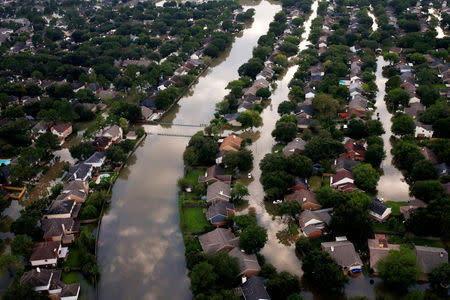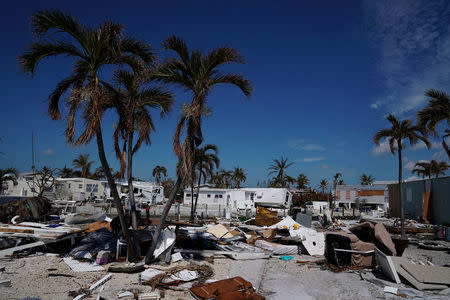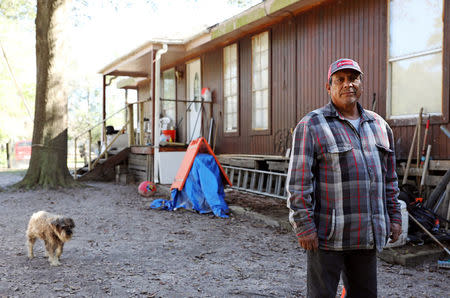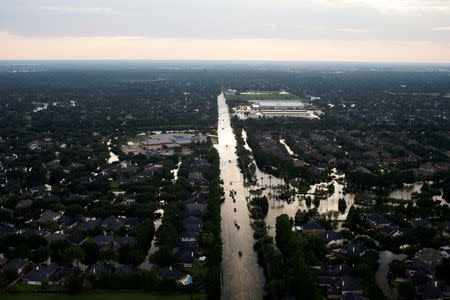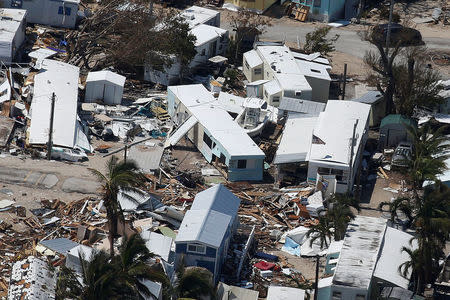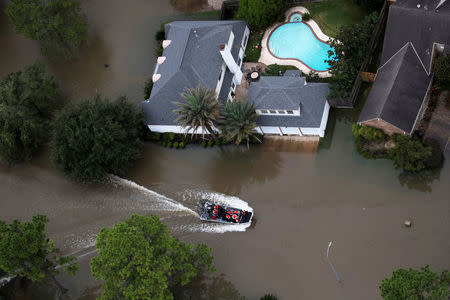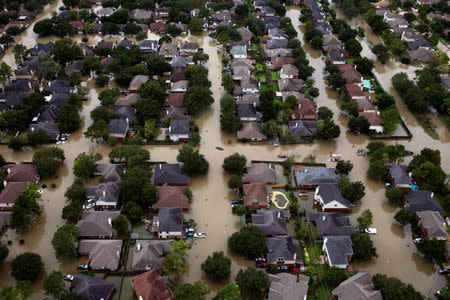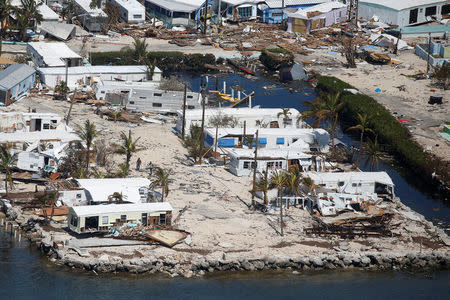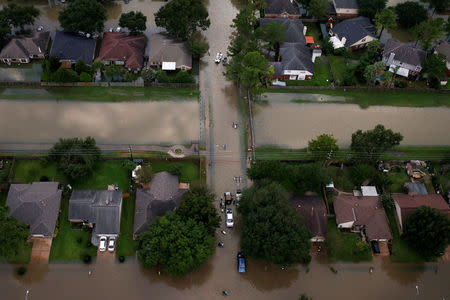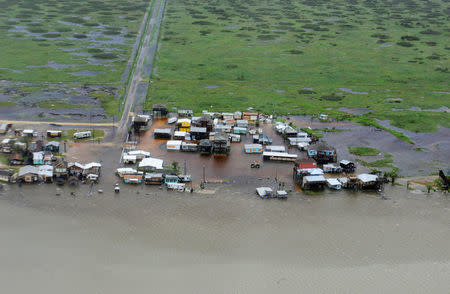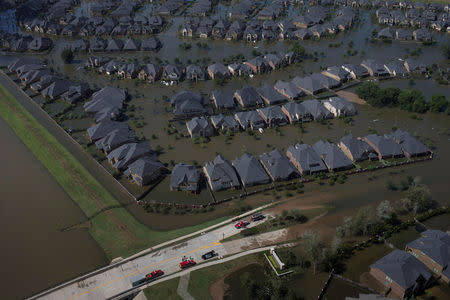Special Report: Unfettered construction raises U.S. hurricane costs
By Benjamin Lesser and Ryan McNeill
PATTON VILLAGE, Texas (Reuters) - When Hurricane Harvey sent two feet of water rolling into this small community about 35 miles north of Houston, Alfredo Becerra had to flee his modest 1,500-square-foot house.
Muddy floodwater submerged the furniture and ruined carpet inside the construction worker’s longtime home. He has been living in temporary housing since the storm struck in August. He said the Federal Emergency Management Agency gave him $15,000 in aid.
One month later, across the Gulf of Mexico in Big Pine Key, Florida, moving company driver Byron Keeble lost about $10,000 worth of belongings, including a new sofa and his television, when Hurricane Irma sent a surge of seawater through his rented ground-floor apartment. Keeble said FEMA paid for him to stay in a hotel for a few weeks while he tried to figure out where he would go next.
Floodwaters aren’t the only common thread in the two men’s stories. Also linking them is this: Neither should have been living in harm’s way.
Becerra’s and Keeble’s homes were built or rented out in violation of National Flood Insurance Program rules. Like thousands of others in the hurricane-ravaged Florida Keys and on the Texas Gulf Coast, such houses are undermining efforts to limit flood damage, lower the cost of disaster assistance and reduce claims on the taxpayer-backed federal flood insurance program, a Reuters investigation found.
Similar rule-busting construction has happened in scores of communities across the United States, where local, state and federal officials have failed to enforce regulations intended to restrict building in areas at high risk of flooding.
Across the country, newer construction in flood-prone areas generated more than $9 billion in claims for structural damage on the cash-strapped flood insurance program between 2000 and 2015. Flood-management authorities say that some of those claims probably never would have been filed had proper building controls and accurate flood maps been in place.
“You look at the media images and you see new subdivisions, new strip malls and new buildings with water up to the rooftop. Those are red flags in my mind. Those shouldn’t be happening,” said Paul Osman, floodplain program manager for the Illinois Office of Water Resources.
Controlling construction inside flood-prone areas is critical to keeping flood insurance affordable and reducing post-disaster costs, federal officials say. The primary tool used to ensure communities are doing so effectively is a system of audits of how localities adhere to their own floodplain-management rules. But that system is crippled by a lack of funding and political will, Reuters found in a review of thousands of federal and state documents and dozens of interviews with flood-management authorities.
Many communities go years without these audits, which are conducted by FEMA or state officials and known as community assistance visits. And when serious problems are uncovered, Reuters found, FEMA has been ineffective in forcing communities to fix them.
Hurricanes Irma, which devastated Florida, and Harvey, which inundated vast sections of Texas, have already generated almost $7 billion in flood insurance claims paid. Houston, where $1.3 billion of those claims originated, has not had an audit in at least eight years.
FEMA has leverage: It oversees the National Flood Insurance Program, and can use it to punish a community that fails for years to address problems. The first sanction is probation, which imposes on all policyholders in the community a $50-a-year surcharge on flood insurance premiums until violations are resolved. If the issues aren’t fixed, FEMA can impose a tougher measure: The entire community can be suspended altogether, and all property owners lose access to flood insurance.
Residents and floodplain-management officials told Reuters they think FEMA is reluctant to use these sanctions, however. Of the 22,000 communities participating in the flood insurance program, four are now suspended for failing to enforce floodplain-management rules. Thirty have been suspended for that reason since 1978.
FEMA’s desire is to keep a community in the program “as long as there is any hope of compliance” to avoid stopping regulation altogether, said Rachel Sears, director of FEMA’s floodplain-management division. “We want to keep that relationship intact,” she said. “We only move toward probation or suspension when there is no further hope.”
UNCHECKED RISKS
When Irma made landfall in the Florida Keys, the region was filled with thousands of homes that federal or state officials suspected of having illegal ground-floor enclosures. Those code-breaking homes were unaddressed despite decades of prodding from FEMA.
It is difficult to quantify the costs to taxpayers from the failure to control development in high-risk areas. FEMA doesn’t ask insurance agents and adjusters to identify illegal structures when reviewing claims. And homeowners are allowed to claim losses for a prescribed list of items, including washers and dryers, even if they had been kept in an illegal basement or low-lying enclosure.
All of this stresses an insurance program that the Government Accountability Office, a congressional watchdog, considers to be at high risk of fraud, waste and mismanagement. Until recently, the National Flood Insurance Program owed $25 billion to U.S. taxpayers because it borrowed to cover past disaster losses. In August, President Donald Trump signed a disaster relief bill that forgave $16 billion of that debt. Congress is still considering a long-term fix to the program.
Eric Letvin, a deputy assistant administrator for the National Flood Insurance Program, said he thinks FEMA is largely successful at ensuring communities control risky development. But he acknowledged the agency could do better.
“It’s one of the areas I want to focus on for improvement, especially in the post-disaster environment,” he said.
Only 23 percent of the more than 22,000 communities that participate in the flood insurance program had an audit by federal or state floodplain-management authorities in the eight years ending in 2016, FEMA documents show.
Some communities may not need an audit: They have little new development or a low risk of flooding. But the list of areas without a recent visit includes fast-growing major cities like Miami and Houston, each of which has seen severe flooding recently.
In interviews with Reuters, state and local officials in Texas could not recall the last time federal or state auditors visited Houston, but it has been at least eight years.
“I don’t know,” said Jamila Johnson, who took the helm of the city’s floodplain office in 2009. “That was before I became the city’s floodplain manager.”
FEMA recommends to each state that an auditor visit all high-risk communities every five years. In its 2010 risk ratings, it listed Houston as the top priority in Texas for auditing.
Texas is not alone. In 13 of 50 states, no federal or state auditor visited the highest-risk community between 2009 and 2016, a Reuters review of FEMA documents found.
FEMA isn’t keeping up, either. Despite its own guidance requiring it to produce community risk ratings annually, it hasn’t done so since 2010.
Meanwhile, building continues in many flood-prone areas. There is no comprehensive way to quantify flood damage to properties built illegally. But if newer structures are built in adherence with the rules, flood specialists said, such buildings should rarely flood. Communities with many illegal buildings or inaccurate maps, on the other hand, are likely to have a high percentage of flood insurance claims from new structures in risky areas.
A Reuters analysis of all flood insurance claims filed between 2000 and 2015 found that, nationwide, 27 percent of claims in high-risk areas came from owners of newer structures. States with a high percentage of such claims included Alabama (59 percent), Mississippi (50 percent), and North Carolina (44 percent).
About 41 percent of claims in Florida and 31 percent in Texas came from newer structures.
The total cost of insurance claims for structural damage to new buildings in risky areas, in adjusted 2017 dollars: $9.5 billion.
On top of that, as in the cases of Becerra and Keeble, FEMA sometimes doles out disaster aid. Data are not available to ascertain how much of that aid goes to people living in illegal structures.
Such losses suggest something is awry, floodplain managers and researchers said. Either the community is failing to enforce its floodplain-management rules, or maps do not accurately detail the community’s flood risk.
FEMA delegates the job of conducting most audits to state officials. Those officials, in turn, say they lack resources to visit more communities. For each of the past five budget years, FEMA has allotted a total of $10.4 million to the states and territories, which must match 25 percent of the money. But the dollars must also be spent on other initiatives, such as public outreach.
The number and frequency of visits varies widely by state. In Florida, FEMA and state officials have visited 64 percent of the communities participating in the flood insurance program. In Texas, the number is 12 percent.
Alfredo Becerra’s flooded home is but one example Reuters found of the results of decades of lax oversight in the Houston area.
Becerra’s property is in a floodway – an area that carries the bulk of any floodwaters downstream and where the most destructive damage is likely. Under FEMA regulations, when Becerra built his home in 1985, Patton Village officials should have required that the house be certified as standing at an elevation above expected flood levels. City officials were also obliged under FEMA rules to require an engineering study to prove the structure wouldn’t cause floodwaters to rise even higher, damaging other properties.
Patton Village officials had no records indicating any of those steps were taken. Becerra said he did not know his property was in a floodway.
He received temporary housing assistance that paid for his stay in a hotel for at least two weeks. He says he also received $15,000 in federal disaster aid to repair the damage to his home. He did not have flood insurance.
Leah Tarrant, the mayor of Patton Village since 2013, acknowledges the village hasn’t done its part to control development.
“Honestly, we have never really dealt with floodplain management,” she said. “I’m just being honest with you.”
In surrounding Montgomery County, dozens of properties in multiple communities were built after official flood maps detailed the floodway and floodplain boundaries, according to a March 2017 FEMA audit of the county and a Reuters analysis of appraisal records and flood maps. Many of the houses had no evidence of the required hydrologic studies or proof that the building’s lowest floor exceeded the expected heights of floodwaters. Some flooded during Harvey.
Most of the properties identified by Reuters are in unincorporated areas, which fall under the jurisdiction of county government.
When questioned about the floodway structures, Mark Mooney, the county’s floodplain manager, said the county banned development in the floodway until 2014. He said he couldn’t explain how, if such a ban was in place, so many homes had been built inside the floodway over the last three decades.
“Some of the listed properties could have been constructed without the county being contacted for necessary permits,” Mooney said. “Unfortunately, we do not have a staff that can police daily, when and where everything gets built in our large county. We will definitely follow up.”
RESISTANCE AND POLITICS
Reuters obtained documents from FEMA summarizing the results of 6,253 audits of floodplain-management enforcement conducted between 2009 and 2016 in all 50 states. Auditors identified serious issues in 13 percent of those visits.
It often takes years, or even decades, to bring a community into compliance after an audit failure. As of Jan. 1, 2017, serious violations remained unresolved for three years or longer in 119 communities across the country. That list includes places at high risk of flooding such as Boca Raton, Florida, and St. Bernard Parish, Louisiana.
Monroe County, Florida, where FEMA spent decades trying to eliminate illegal construction, shows why so many known problems persist: Community resistance and politics often impede enforcement efforts.
Years before Hurricane Irma struck the county, authorities identified thousands of suspected illegal enclosures. By the time the storm hit, they had not yet inspected half of those properties to see if they complied with floodplain codes. As of the end of November, the county’s property owners had been paid $62 million in insurance claims for flood damage from Irma.
FEMA first noticed problems in Monroe County during two visits in the 1980s. But the county’s leadership was uncooperative and remained so for years, said Brad Loar, who retired in 2014 as director of the FEMA Region IV mitigation division.
“They pretty much resisted anything that we wanted to talk to them about,” said Loar, who was involved in the first FEMA visit in 1982. “We didn’t see a whole lot of understanding or corrective action for most of the whole thing.”
What auditors found in Monroe County is typical of the Florida Keys. Living space in high-risk areas is supposed to be elevated above expected 100-year floodwater heights. Here, though, property owners often furnish ground-floor enclosures, either to expand their living space or to rent out the extra rooms. The low-rent enclosures are popular with the waiters, cooks, maids and other service industry workers essential to the area’s tourism industry.
When FEMA officials returned to audit Monroe County a third time in 1995, they found the illegal living spaces had become so widespread that sanctions were warranted.
Had FEMA placed Monroe County on probation after the 1995 visit, the agency would have put one of the most hurricane-prone areas in the country on the road to losing flood insurance. Instead, FEMA pressured the county to agree in 2002 to a pilot project that called for inspections of about 5,700 properties.
Property owners with insurance were told they needed to request an inspection from the county before renewing their policies. Also, owners of the 5,700 properties who sought a building permit for any reason had to agree to an inspection.
The inspection program caused a row in county politics that lasted 11 years. Although county government had begun cooperating with FEMA, contractors complained that the inspections deterred residents from upgrading their homes. Residents complained they couldn’t sell their places. Local, state and federal officials faced calls from residents and contractors to end the inspections.
In 2011, homeowners and contractors lobbied the Florida legislature to ban local authorities from conducting the building-permit inspections. FEMA officials argued against the legislation until, local activists said, U.S. Senator Bill Nelson, a Florida Democrat, stepped in and pressured the agency to back off.
“It was huge,” lobbyist John November said of Nelson’s involvement. “Without his participation … that pilot program might still be going on.”
By the time the pilot program ended in 2013, only half of the 5,700 properties FEMA suspected of having illegal enclosures had been inspected.
Despite the lingering problems, Monroe County is a FEMA poster child. The agency describes the community as “one of the best examples” of compliance in the country.
(Additional reporting by Gary McWilliams. Edited by Janet Roberts.)
